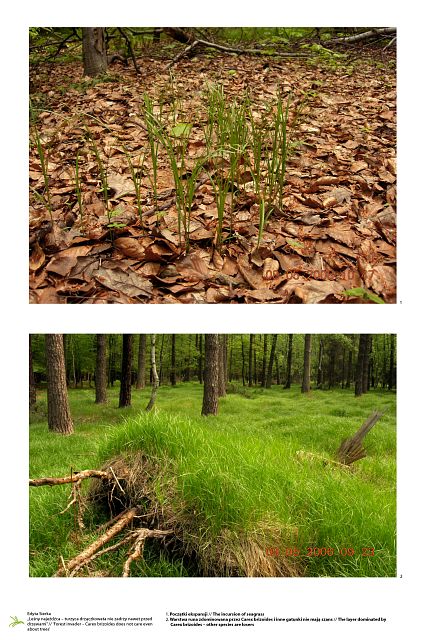
Description popularizing the research project
And yet again there is something wrong. A green forest grows and soughs. Towering pines reach the sky. Indeed it is a monoculture and it is never good when a stand is composed of only one tree species. But this one looks healthy. Yet there is something what makes you anxious. Something what makes you look carefully around and under your feet. You will not find heathers and wild strawberries here although the undergrowth is dense. Even a child knows that in a forest there should be mushrooms and berries. Moss should mingle with grass and sedges. In this forest there are only sedges and it is worrying. Carex brizoides really does not care about others plants. In more and more Silesian forests the undergrowth is dominated by the species. It spreads in all directions with its underground stolons and drives other known and beautiful plants like anemones, violets, wood sorrels, cowberries, berries and ferns. You have to admit that the aggressive plant has its charm and grace when it bows its shimmering blades low to the ground and when they ripple they resemble rough water. That is probably why in older publications it is referred to as seagrass. Nevertheless in the beauty a danger stalks as the merciless sedge does no give a chance to even tree seedlings. How is it possible that a forest is helpless in a confrontation with the fragile plant?
Will our forests which have survived pollution and forest management, surrender to the dictate of the sedge?
Abstract
"The patch is composed of a sedge called seagrass... It forms dense concentrations as if they are bending bushy shags on the ground. Its belowground stolons keep creeping forward and aside, choke and destroy the whole vegetation it meets on its way. This way, step by step, it conquers and takes every area over..."(Karpiński; 1960).
The changes which took place in the past, as a result of indirect (industrial emissions) and direct (e.g. forest management) human impact on forest communities, led to massive spreading such expansive plant species Carex brizoides.
The aim of the presented project is an attempt to point out causes and effects of domination of Carex brizoides in forest phytocoenoses, in the light of studies conducted in other regions of the country, with special attention to the influence of this plant on the biodiversity of forest communities and its impact on forest crops.
The investigations are carried out on permanent study plots within all-aged tree stands and forest crops. The species composition of ground layer with and without this species against the background of biotopic conditions is analyzed.
The initial results revealed the reductive impact of Carex brizoides on remaining components of plant communities including seedlings of trees.
The forest communities over-dominated by Carex brzoides are characterized by monotonous appearance. This type of degeneration, called cespityzation, is frequently recorded in the Silesian Upland.

